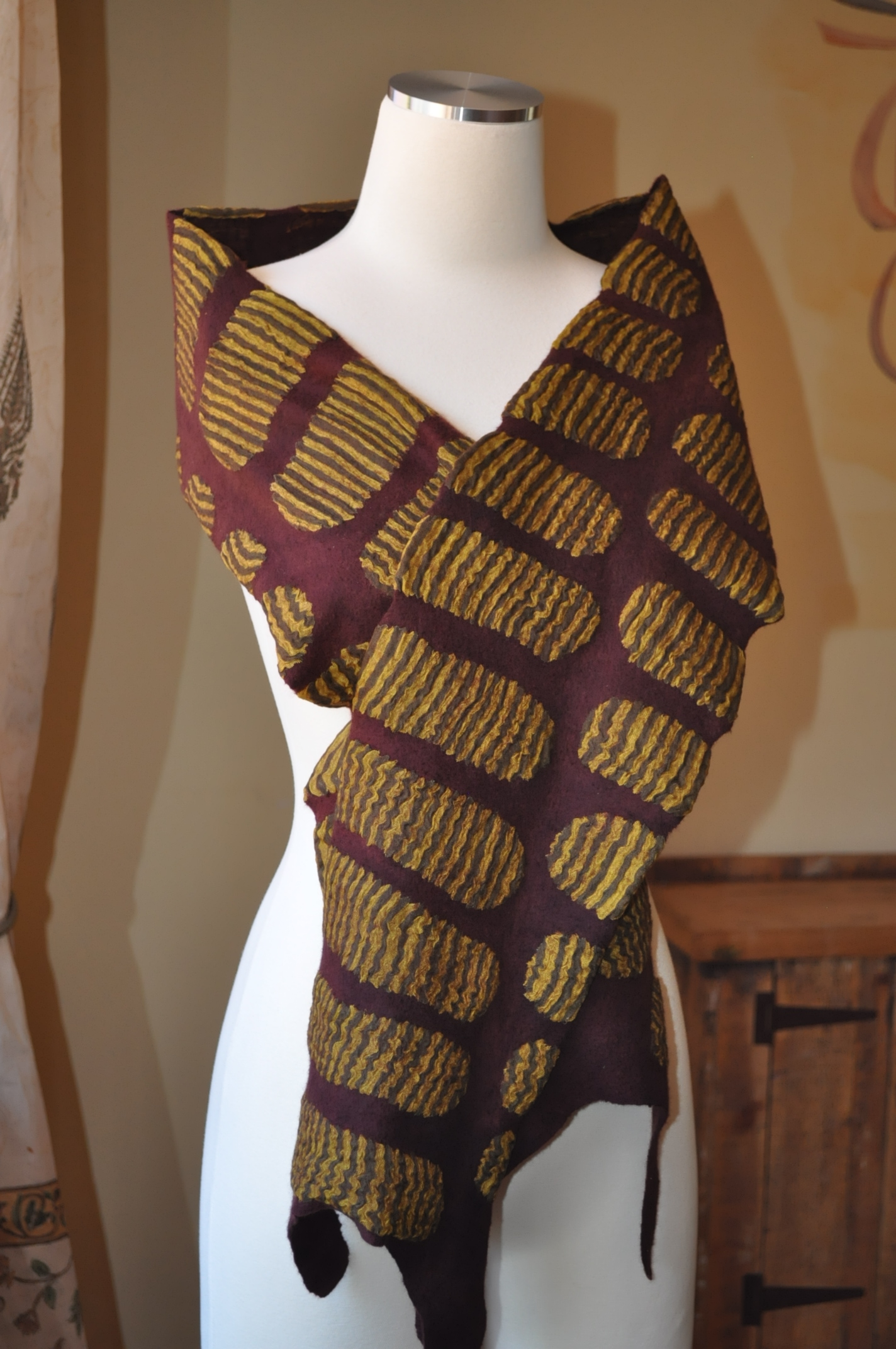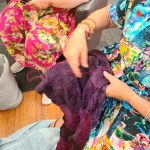
I love to felt. And for me, a huge part of that joy comes from seeing the magical transformation from fibre to felt that happens literally in my own hands. But like every good magician knows, in order to achieve that great result, there’s a lot of meticulous preparation required behind the scenes.
In the world of felting, these are things we all know and do, but since I’m writing about quality felt, I think it’s important to go back to the basics. So please bear with me while I attempt to put down my thoughts on creating quality felt….
Take the felting process through to completion and with care
I know this sounds obvious but I also know how tempting it can sometimes be to hurry things up.
To begin with, lay out the wool evenly, thin wisps at a time, without too much of an overlap between rows. This will reward you with a consistently fine finish. Much better than clumpy laying which ends up being thick or thin in places – not good. Confucius says: Anything worth doing is worth doing well.
I also believe more fine layers are better than fewer thick ones. Especially for wearables, as you will end up with stronger felt with more movement or stretch, as opposed to a stiffer piece of felt.
Check regularly that the work is coming along as expected. Which means no extra-long bouts of rolling. This way you can also catch any problems before it is too late to fix them.
Don’t skip steps. They all have a part to play in creating good, strong felt.
As we know, different wools and silks behave differently; some work like magic, while with others you’re in for the long haul. So be patient, take deep breaths and drink lots of cups of tea.
Think about your design
What’s the point of all that hard work if a piece isn’t beautiful to look at? The design of a piece really is the first thing that attracts the eye, so it is worth thinking about. In my opinion, colour, composition and balance are the three main elements to consider.
Colour – Colours have an amazing ability to influence our moods and can therefore be a very powerful design tool. I find it amazing how, even using just two colours, you can get two completely different looks simply by changing the proportion of each colour in a design. You may also be surprised at how the most unlikely colours can actually look good together. While classic combinations of colour will always work, it’s the unusual pairing of hues that bring originality and freshness to a design. For instance, orange and red do go well together… trust me, I’ve tried it! Colour is also a simple way to expand your comfort zone, to go where you may not have gone before. A basic understanding of colour ‘groups’ will help with colour scheme ideas. Warm colours, cool colours, pastels, bright colours, neutrals, etc. Most libraries have good books on the topic.
And where do you find inspiration for new colour combinations? Just look around you, they’re everywhere. In our landscape, printed textiles, jewellery, other people’s outfits, and other unexpected colour juxtapositions that happen all the time. Magazines and craft books offer a wealth of colour inspiration too. Or, when you find yourself surrounded by your bags of different coloured wools and silks, etc, try placing two or three colours side by side, then stand back and assess. Keep changing them until you arrive at a combination that makes you smile and want to dive straight into your next project. And do give that hated colour a whirl too… it might surprise you when used in the right combination.
Which brings me to the next point, that a pre-conceived colour scheme generally yields better results than adding bits of colour as the whim strikes. But, if you prefer a ‘colour-as-you-go’ method, then spare a few moments after you’ve laid it all down, to stand back and assess if it does indeed work together, or if some changes might be needed.
Composition
As we know, the positioning of elements in a design is called the layout or composition of a piece.
Generally speaking, placing things off-centre rather than in the middle; using an odd instead of an even number of elements and the repetition of a shape or form, are some basic principles of good design. Asymmetry is usually more interesting than a perfectly symmetrical (and often boring), design.
It’s also useful sometimes, after you’ve laid it all out, to try moving things around or removing an element or two. Stand back, look at it objectively. And be ruthless. Just because it took an hour to cut out all those flowers doesn’t mean they should all be there. Maybe just a few would do the trick and the rest would look stunning on another piece of work.
Balance
Do all the elements in your design sing in harmony? This can be tricky, but the more you think about it and practice it, the easier it will get. An obvious example of an unbalanced piece would be if one section were very detailed and the rest looked like it hadn’t been spared much thought. It’s about keeping things relatively proportionate. For wearables especially, it is important that one side or half not be visually heavier than the other – not symmetrical, but balanced. Standing back and viewing always helps. (As you would have gathered, I do it a lot.) And it’s best to make any changes before you begin wetting things down. Wet wool doesn’t like to be moved.
I will take a teeny, weeny bit of space here to make a case for post-felting embellishment. Not every piece will cry out for a needle and thread, I know, but there are times where just a little bit of decorative stitching or beading or whatever, will lift a piece straight out of the ordinary.
And finally,
Construct a piece according to its purpose
This includes basic considerations such as how many layers you would need, what kind of wool you should use and the direction of laying. Which will lead you to secondary issues, like shrinkage calculation. Should you use a batt or lay down wool tops. Do you need to consider reinforcing certain areas like the soles of slippers? It’s essential to think the whole process through before you begin. For example, to create a bowl with a very firm 3-D feel, it might be best to felt around a spherical resist. With handbags for example, internal pockets, external pockets, etc are all elements that require planning at the construction stage, as you lay down the wool and resists for each. I also think there’s nothing wrong with sewing a piece together after felting it, instead of a single piece construction, if the piece would be better for it. Take the time to think it all through before you begin.
In closing, there’s one more thing I’d like to add. Don’t be afraid to change any aspect of the felting process if you think it would yield better or unexpected results. And just because something hasn’t been tried before doesn’t mean it won’t work. Remember, all the wonderfully quirky, one-of-a-kind felted objects you’ve ever seen have come about because someone tried out something new, and changed the usual felting trajectory to accommodate a new creation.
So go forth and felt. And know that you’re making the world a better place, one beautiful piece of felt at a time.
Alison Gomes








